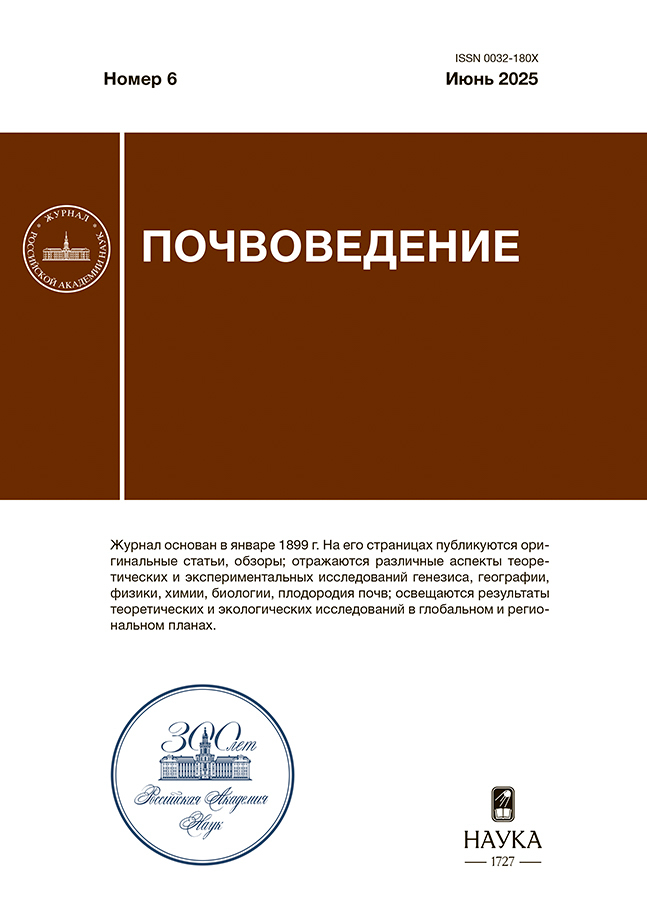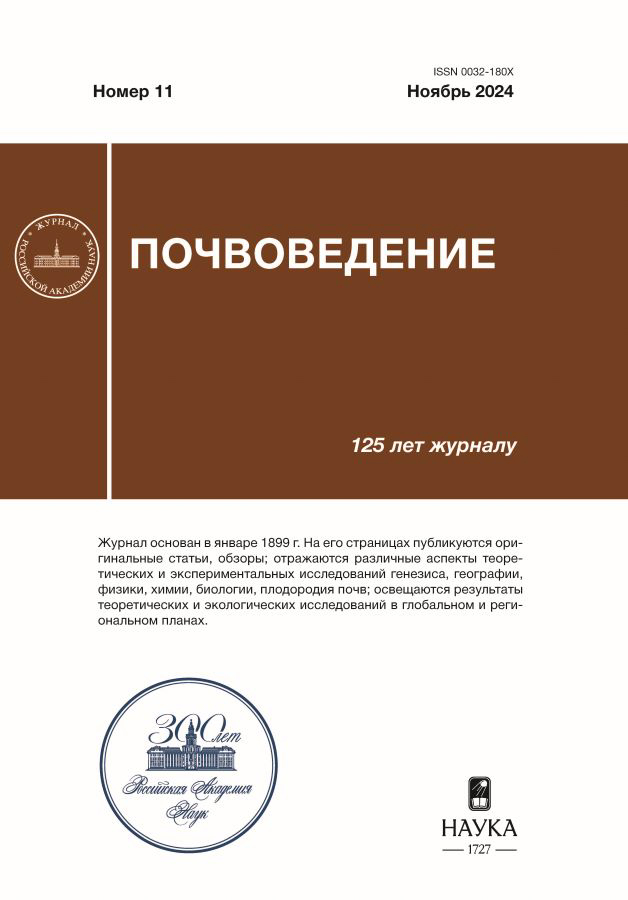Pool of Lignin Phenols in Soils of Secondary Forests
- Authors: Kovalev I.V.1, Kovaleva N.O.1
-
Affiliations:
- Lomonosov Moscow State University
- Issue: No 11 (2024)
- Pages: 1619-1629
- Section: ORGANIC MATTER OF SOILS OF SECONDARY FOREST ECOSYSTEMS
- URL: https://freezetech.ru/0032-180X/article/view/677888
- DOI: https://doi.org/10.31857/S0032180X24110131
- EDN: https://elibrary.ru/JNSNVL
- ID: 677888
Cite item
Abstract
The purpose of the study is to characterize the pool of lignin phenols in the soils of two contrasting secondary forest ecosystems – boreal and tropical – under different tree species and to assess the rate of biochemical transformation of difficult-to-degrade lignocellulosic compounds in them. A detailed and comparative description of the biochemistry of lignin in soils in experiments on artificial afforestation in the Krasnoyarsk region of Russia (Gray Phaozems Albic) and in the Amazon (Brazil) (Xanthic Ferralsol) is presented. Determination of lignin in soils involved alkaline oxidation with copper oxide at 170°C under pressure in a nitrogen atmosphere. Lignin phenols (vanillin, syringyl and cinnamyl) were separated using gas chromatography. It has been shown that in soils of secondary forests, both boreal and tropical, a rapid process of lignin mineralization is observed in comparison with soils of natural zonal ecosystems. A characteristic feature of the process is a significant enrichment of lignin with metabolic carbon. Low lignin content, a high degree of oxidation of biopolymers and a high degree of transformation are characteristic of the soils of all studied secondary forests and especially of tropical ones, which reduces the potential of the latter as carbon sink reservoirs compared to taiga soils.
Full Text
##article.viewOnOriginalSite##About the authors
I. V. Kovalev
Lomonosov Moscow State University
Author for correspondence.
Email: kovalevmsu@mail.ru
Russian Federation, Moscow, 119991
N. O. Kovaleva
Lomonosov Moscow State University
Email: kovalevmsu@mail.ru
Russian Federation, Moscow, 119991
References
- Карпачевский Л.О., Зубкова Т.А., Ковалева Н.О., Ковалев И.В., Ашинов Ю.Н. Почва в современном мире. Опыт популярного изложения вопросов современного почвоведения. Майкоп: ОАО “Полиграф-Юг”, 2008. 164 с.
- Ковалев И.В., Ковалева Н.О. Пул лигниновых фенолов в почвах лесных экосистем // Лесоведение. 2016. № 2. С. 148–160.
- Моделирование развития искусственных лесных биогеоценозов / Под ред. Орловского Н.В. Новосибирск: Наука, 1984. 150 с.
- Указ Президента РФ № 666 “О сокращении выбросов парниковых газов в РФ” 2020.
- Шугалей Л.С., Ведрова Э.Ф. Многолетний эксперимент по взаимодействию основных лесообразующих пород с агросерой почвой: история создания и первые результаты // Творческое наследие профессора Н.В. Орловского, его использование и развитие: Материалы научных чтений. 2014. Т. 115. С. 95–101.
- Amelung W. Zum Klimaeinfluβ auf die Organische Substanz Nordamerikanischer Praärieböden. Bayreuth, 1997. 131 p.
- Angst G., Kogel-Knabner I., Mueller K., Freeman K. Aggregation controls the stability of lignin and lipids in clay-sized particulate and mineral associated organic matter // Biogeochemistry. 2017. V. 132. P. 307–324.
- Bogatyrev L.G., Telesnina V.M., Semenyuk O.V., Benediktova A.I. The dynamic of the morphology and chemical properties of forest litter during natural postagrogenic reforestation and its effect on the ground cover // Moscow University Soil Science Bulletin. 2020. V. 75. № 3. P. 101–108.
- Ertel J.R., Hedges J.I. The lignin component of humic substances: distribution among the soil and sedimentary humic, fulvic and baseinsoluble fractions // Geochim. Cosmochim. Acta, 1984. V. 48. P. 2065–2074.
- Freidenberg К. Principles of lignin growth // J. Polymer Sci. 2003. V. 48. P. 371–377.
- Hedges J.I. and Mann D.C. The Characterization of Plant Tissues by Their Lignin Oxidation Products // Geochim. Cosmochim. Acta. 1979. V. 43. P. 1803–1807.
- IUSS Working GroupWRB. 2022. World Reference Base for Soil Resources. International soil classification system for naming soil and creating legends for soil map. 4th edition. International Union of Soil Sciences (IUSS), Vienna, Austria.
- Kogel I. Estimation and decomposition pattern of the lignin component in forest soil // Soil Biol. Biochem. 1986. V. 18. P. 589–594.
- Kogel-Knabner I., Guggenberger G., Kleber M., Kandeler E., Kalbitz K., Scheu S., Eusterhues K., Leinweber P. Organo-mineral associations in temperate soils: Integrating biology, mineralogy, and organic matter chemistry // J. Plant Nutr. Soil Sci. 2008. V. 171. P. 61–82.
- Kogut B.M., Semenov V.M. Estimation of soil saturation with organic carbon // Dokuchaev Soil Bulletin. 2020. V. 102. P. 103–124. https://doi.org/10.19047/0136-1694-2020-102-103-124
- Kovalev I.V., Kovaleva N.O. Biochemistry of lignin in soils of periodic excessive moistening // Eurasian Soil Science. 2008. V. 41. P. 1066–1076.
- Kovaleva N.O., Kovalev I.V. Transformation of lignin in surface and buried soils of mountainous landscapes // Eurasian Soil Science. 2009. V. 42. P. 1270–1281.
- Kovaleva N.O., Kovalev I.V. Lignin phenols in soils as biomarkers of paleovegetation // Eurasian Soil Science. 2015. V. 4. P. 946–958.
- Kovalev I.V., Semenov V.M., Kovaleva N.O., Lebedeva T.N., Yakovleva V.M., Pautova N.B. Estimation of the Biogenicity and bioactivity of gleyed agrogray nondrained and drained soils // Eurasian Soil Science. 2021. V. 54. P. 1059–1067.
- Khitrov N.B., Nikitin D.A., Ivanova E.A., Semenov M.V. variability of the content and stock of soil organic matter in time and space: an analytical review // Eurasian Soil Science. 2023. V. 56. P. 1819–1844 https://doi.org/10.1134/S106422932360207X
- Lin Y.-H., Lee P.-C., Menyailo O.V., Cheng C.-H. Changes in soil organic carbon concentration and stock after forest regeneration of agricultural fields in Taiwan // Forests. 2021. V. 12. P. 1222. https://doi.org/10.3390/f12091222
- Lukina N., Kuznetsova A., Tikhonova E., Smirnov V., Danilova M., Gornov A., Bakhme O. et al. Linking forest vegetation and soil carbon stock in Northwestern Russia // Forests. 2020. V. 11. P. 979.
- Menyailo O.V. Forest soil carbon and climate changes // Forests. 2022. V. 13 . P. 398. https://doi.org/10.3390/f13030398
- Menyailo O.V., Sobachkin R.S., Makarov M.I., Cheng C.-H. Tree Species and Stand Density: The Effects on Soil Organic Matter Contents, Decomposability and Susceptibility to Microbial Priming // Forests. 2022. V. 13. P. 284. https://doi.org/10.3390/f13020284
- Menyailo O.V., Hungate B.A., Zech W. Tree species mediated soil chemical changes in a Siberian artificial afforestation experiment // Plant and Soil. 2002. V. 242. P. 171–182.
- Parton W.J., Schimel D.S., Cole C.V. und Ojima D.S. Analysis of factors controlling soil organic matter levels in Great Plain grasslands // Soil Sci. Soc. Am. J. 1987. V. 51. P. 1173–1179.
- Schroth G., Ferreira da Silva L., Wolf M.-A., Teixeira W.G., Zech W. Distribution of throughfall and stemflow in multi-strata agroforestry, perennial monoculture, fallow and primary forest in central Amazonia, Brazil // Hydrological Processes. 1999. V. 13. P. 1423–1436.
- Schroth G., Ferreira da Silva L., Seixas R., Teixeira W.G., Jeferson L.V., Zech W. Subsoil accumulation of mineral nitrogen under polyculture and monoculture plantations, fallow and primary forest in a ferralitic Amazonian upland soil // Agriculture, Ecosystems Environment. 1999. V. 75. P. 109–120.
- Totshe K.U., Amelung W., Gerzabak, Guggenberger G., Klumpp I., Ray N., Kogel-Knabner I. Microaggregates in soils // J. Plant Nutrition Soil Sci. 2017. V. 181. Р. 1–33.
- Wu J., Deng Q., Hui D., Xiong X., Zhang H., Zhao M., Wang X., Hu M., Su Y., Zhang H., et al. Reduced lignin decomposition and enhanced soil organic carbon stability by acid rain: evidence from 13C isotope and 13C NMR analyses // Forests. 2020. V. 11. P. 1191.
- Ziegler F., Kögel I. and Zech W. Alteration of gymnosperm and angiosperm lignin during decomposition in forest humus layers // Z. Pflanzenernaehr. Bodenk. 1986. V. 86. (P. 323–331.
- Zech W., Senesi N., Guggenberger G., Kaiser K., Lehmann J., Miano T. M., Miltner A., Schroth G. Factors controlling humification and mineralization of soil organic matter in the tropics // Geoderma. 1997. V. 79. P. 117–161.
Supplementary files











